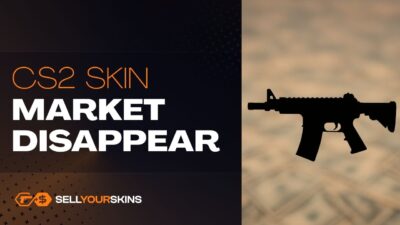In theory – yes. In practice – almost never. This is one of the most frequently asked questions among players who own high value skins in their inventory. And it’s no surprise: some of them can cost as much as a brand new computer. But since the entire platform belongs to Valve, does the company have the right to “take” these items? The answer requires understanding how the digital ownership system on Steam works and under what circumstances you can actually lose your skins.
Want to sell your skins for real money? Visit our homepage.
Technically, the skins are not “yours”
From a legal perspective, all CS2 skins remain the property of Valve. Players only acquire the right to use them within their Steam account, according to the platform’s terms of service. In practice, this means Valve can block access to items, suspend accounts, or restrict trading at any moment. It sounds alarming, but it’s standard across the online gaming industry – similar clauses appear in the terms of EA, Riot Games, or Ubisoft. It’s not that the company plans to “take” your skins, but rather that it has legal safeguards in case the rules are violated.
When does Valve actually take skins away?
In the vast majority of cases, Valve does not manually remove items. Most often, access to them is automatically blocked when a VAC-ban or another cheating-related penalty is applied. In such cases, the inventory becomes permanently tied to the account and loses all market value – it cannot be sold, traded, or transferred. The skins still exist, but they are “frozen”. This is the only situation in which you can reasonably talk about losing access to your skins. Valve does not confiscate items from accounts that follow the rules – even if someone’s inventory contains skins worth tens of thousands of dollars.
Why doesn’t Valve “take away” skins without a reason?
From a business standpoint, it would be shooting themselves in the foot. The CS2 market exists thanks to the community’s trust – if players believed their digital items could disappear for no reason, the entire in-game economy would collapse within days. Skins have value because players trust they are safe and can be sold, traded, or kept for as long as they want. For over a decade, Valve has consistently maintained the stability of the system – even during difficult moments such as phishing attacks, trading bugs, or scams. Instead of taking items away, the company blocks cheaters’ accounts, but generally does not touch the inventories of players who haven’t broken the rules.
What can actually make you lose your skins?
The biggest threat is not Valve, but… other users. Most cases of losing skins result from phishing or scams – fake websites pretending to be Steam, fraudulent trade bots, or impersonators. In these situations, the player accepts a trade themselves, often unknowingly, and loses valuable items. That’s why you should:
- never click trade links outside of Steam,
- always verify the account ID,
- use Steam Guard for protection,
- keep your most valuable skins on a separate account that you don’t use for regular gameplay.
These basic precautions practically eliminate most of the risk of losing CS2 skins.
And what if Valve… goes bankrupt?
In theory, this is the only scenario in which all players would lose access to their skins. If Valve shut down or Steam servers were turned off, the entire ecosystem would cease to exist. Even the most expensive inventory would lose its value because there would be nowhere for it to “exist.” However, this is a purely hypothetical scenario – Valve is one of the most financially stable companies in the industry, with enormous reserves and steady revenue growth from CS2, Dota 2, and Steam.
Can Valve take away your skins?
In theory – yes. In practice – only if you break the rules or cheat. Under normal conditions, your skins are safe. Valve has no incentive to take items from honest players, and any such action would destroy the company’s reputation and community trust. If you don’t cheat, don’t fall for scams, and keep your account secure – you can sleep peacefully. Your skins remain yours for as long as the game that created them exists.



